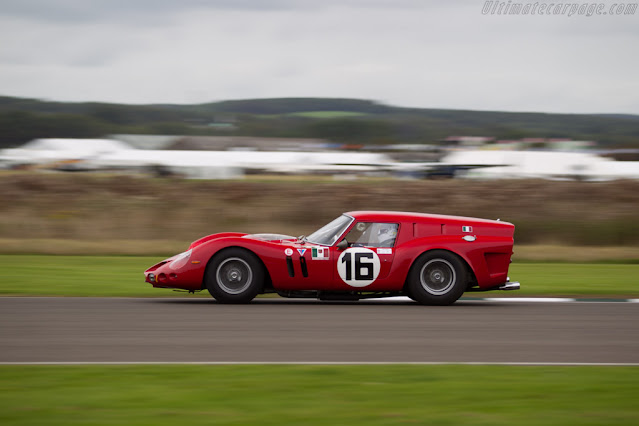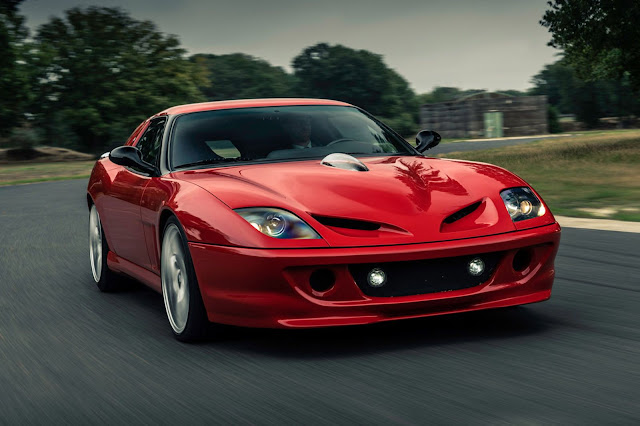Somewhere in the world, or on the internet, there must surely exist a master list of all the cool things that have happened as a result of people being pissed off with Enzo Ferrari. There's the obvious stuff, of course, like the Ford GT40 story, or tractor manufacturer Ferruccio Lamborghini responding to Il Commendatore's flippant dismissal of his criticisms around the 250 GT by starting to build rival cars of his own. But there is also the lesser famed stuff, like the set of highly rated engineers who quit Ferrari all at once in 1961 and founded both the Bizzarrini and Automobili Turismo e Sport (ATS) sports car companies – albeit to far less success than Lamborghini.
Oh, also there was the Jerrari...
Anyway, I bring this up now because one of those companies, ATS – which can lay claim to producing the first ever mid-engined road car in the 2500GT – is related to the backstory behind the inspiration for the striking coachbuilding project you see a sketch of above, the final product of which was digitally revealed this week.
ATS was backed financially by Count Giovanni Volpi di Misurata, whose (also extremely Italian sounding) racing team Scuderia Serenissima had raced various different Ferraris for several years. When Enzo Ferrari discovered that Count Volpi was funding his deserters and their new rival manufacturer, the relationship that had existed between the two men vanished in a flash. Suddenly Volpi was out of the loop, which became a problem when he wanted to upgrade his 250 GT SWB to the trick new GTO that was about to take road racing by storm – only for him to be refused and turned away.
 |
| 250 GTOs are now so valuable than I can only afford to show you this wireframe design model |
Plainly, the trendy new thing to do in the early 1960s when Enzo shut you down was to get mad, then try to get even with your own car. Rather than start from scratch like Lamborghini and the ATS founders (Carlo Chiti and Giotto Bizzarrini), he decided to work with what he already had: Ferrari 250 SWB Competizione chassis 2819GT. His new business partner Bizzarrini, who prior to the Ferrari "palace revolt" had worked on the very GTO that Volpi was denied, agreed to take part in upgrading and enhancing the car into something of equal or greater competitiveness.
The resulting machine was reportedly around 65-100kg lighter than a GTO, while the V12 engine was mounted lower and further back in the chassis and received a dry sump conversion, plus six carburettors for good measure. The power boost was modest, with around 300hp versus 286, but the improved weight balance of its revised installation would benefit cornering dynamics too.
 |
| Count Volpi's transformed 250 GT, ahead of the car it used to be (photo from UltimateCarPage.com) |
However, the most obvious transformation was on the outside. To yield even more straight-line speed, the car was given an all-new body designed by Piero Drogo. The nose is so low that the engine, even in its new lowered position, pokes through the bonnet. But that's not the bit that grabs your attention. The new roof, however, wasn't only lower than that of the GTO, it was also significantly longer and straighter with a near-vertical tail at its abrupt end.
The tapering 'Kamm-tail' roof concept, combined with a lack of additional side glass to run along it, gave the car the appearance of a squashed commercial vehicle. French media dubbed it 'La Camionette' (little truck). In English, however, it is known as the 'Breadvan'.
In its first race, nothing less than the 1962 Le Mans 24 Hours, the Bizzarrini-Drogo 250 Breadvan overtook every Ferrari 250 GTO in the field and ran as high as 7th overall before suffering a driveshaft failure in the fourth hour. In the following two races, it took GT class victory at the Brands Hatch Guards Trophy and Ollon-Villars hillclimb (setting a course record for GT cars in the latter).
Point made, one feels – and the aero philosophy which gave the car its, erm, distinctive rear end was then applied to several subsequent cars in the years that followed, if often somewhat less brutally.
Due to limited resources for development, the Breadvan didn't race for long in period with most of its work done in 1962, but it is now a regular fixture at major historic motorsport events such as the Goodwood Revival races and the Tour Auto recreation road rally. Plainly, though, it has appeared here and there enough times to provide a spark of inspiration for one rich car collector.
An anonymous car collector contacted London-based Dutch car designer, Niels van Roij, whose eponymous design company has recently been establishing something of a reputation for taking various cars and making their roofs longer – be it a Tesla or a Rolls-Royce. In my old job I got to see his previous works up close and I can vouch for his small but dedicated team's handiwork, including traditional coachbuilding techniques applied by Bas van Roomen.
Ordinarily at this point I'm used to taking you on a deep dive into the design process behind newly revealed cars, but for this project van Roij has been good enough to make a series of videos detailing every stage of the project. Here's one of them about the exterior:
In short, the 'Breadvan Hommage' is based on a Ferrari 550 Maranello, which has then been analysed inside and out, stripped down to its basic structure and thoughtfully reworked into a more contemporary Camionette festooned from nose to enlarged tail with visual references to the 1960s Drogo-bodied racecar.
 |
| The 550-based Breadvan Hommage, getting its icing piped on |
With a project like this in which you're mashing designs from very different decades together, there is a balancing act between creating a clear visual link to the source material and yet still getting it to sit harmoniously on an altogether different donor-car platform. A straight copy forced onto different proportions could look awful and contrived, but take too much licence (or retain too much of the donor car) and it could become an apologetic or unconvincing instead – merely a weird facelift instead of a true hommage.
The Breadvan Hommage walks this tightrope reasonably well considering that even the 250-based original is an acquired taste in the first place. The front half, already low and pointy anyway, still looks like a 550 Maranello in profile, but with the new roof added this looks like a 550 wearing one of those low-drag cycling helmets.
Naturally it's the rear end that has had the most attention from the team and happily it's also the best resolved aspect, defined by long fast lines carrying a more modern tension while ultimately still forming a 'breadvan'.
The taillights are, I think, the OEM ones from the 550 donor car rearranged to be vertically stacked like those on the Drogo bodied 250, while the cat-flap rear window has been shaped to sit neatly with the forms and graphics around it, instead of being an exact copy of the very basic that'll-do '60s rectangle. The horizontal crease acting as a visual shelf for the glass hatch to sit on is a subtle but important finishing touch, as the blank space below it consequently looks more deliberate and defined.
Van Roij's sketches and videos show that it took countless iterations and detail refinements to arrive at this exact look – such as the gills behind the side window ultimately being arranged to be very similar to the original after trying several other options first. The level of visual refinement in the design has been carried through into sheet metal with matching levels of care and attention to detail in the coachwork.
For me, though, the front-end redesign is less convincing, even if I can see the thinking behind it. Maybe its cheekbones and underlying shape are too recognisably similar to the 550's original design (although fitting round headlights and towering shoulders over the front arches would've been going too far the other way, to be fair). The trapezoidal nostrils in the bonnet are a clear nod to those of the 250 GT Breadvan, while the headlights have been made into a narrower version of the 550's to help give graphic proportions closer to the old car's face.
But the glass dome over the standard V12 is the most dubious bit of the exterior; on the reference car it was necessary for housing the intake trumpets of the race-tuned Colombo engine, whereas here on the Hommage it isn't functional like that and thus feels a little gimmicky.
While the rear end is primarily defined by a small number of large sweeping elements, the nose just looks quite busy relative to both the all-new tail and to the standard Ferrari 550 design that's still visible under the changes.
Of course, there is also the interior to consider, and again there is a delicate balancing act to perform. As with the bodywork (for the same practical and safety-based reasons), they couldn't just cut out the dashboard structure and put a pure '60s replica in its place... but it was quickly decided that all the '90s plastic attached to it simply had to go. In its place is new leather, metal switchgear and air vent bezels, plus a much reduced centre console with only the glorious metal open-gate shifter and some essential buttons sitting separately on a diamond-stitched leather tunnel cover.
The door panel is a sympathetic redesign in itself, with the OEM arrangement of trim panels retained but the blocky grab handle taken off and a swooping metal-framed pull-string mechanism added between the trim panel seams in its place. The seats, meanwhile, are the original (and rare) 550 WSR optional carbonfibre buckets which came with the donor car, now re-trimmed in vibrant blue suede as a nod to the colour scheme seen in other 250 GT racecars (including, ironically, a 250 GTO).
 |
| No black horses on yellow backgrounds here. It's not wise to cross Enzo's successors either... |
The further away from the transmission tunnel you get, the less radical the changes are. The buttons, switches, column stalks and rotary dials are all in the same places as before, but remade in solid metal, while the air vents have thick new bezels and the instruments have retro-chic new clock faces. The OEM 550 steering wheel was probably necessary to keep for its airbag, but aesthetically it's a large element that hasn't gone back in time like the elements around it have, which dents the illusion slightly.
Because it pays tribute to something unique, this too is a one-off vehicle, so if you wanted your own one then I'm afraid you're out of luck. If you aren't a fan of the conversion, by contrast, then don't worry about there being any more examples appearing in future.
The Breadvan Hommage won't go racing like its inspiration did, but what it does have in common with the racecar of revenge created by a small band of ingenious Italian rebels, is a love it or hate it uniqueness, a Ferrari V12 and a manual gearbox. Oh, and plenty of room in the back for fresh ciabatta loaves.









